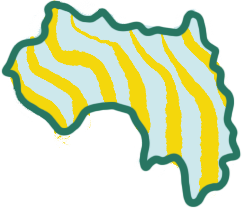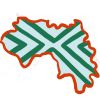Text
In this chapter, we're gonna cover so-called "situative" (also sometimes called "locative") constructions.
This the final of the four non-verbal constructions that can often be translated with the verb "to be" in English (the others being: presentatives, equatives, and qualitative verbs).
As you might guess, they are prototypically used to state where something is "situated" or "located"; for instance, in sentences like, "I am in Guinea", "The child is on the mat", or, more abstractly, "They are in peace."
But, as you'll see and later experience in your learning, they are also used to express things that in English we normally express in a different way; such as, "It is hot" (when commenting on the weather) or "My stomach hurts."
How does it all work? Dɔnɛn-dɔnɛn—little by little!
Specifically, we're gonna cover:
- When you will likely use situatives
- Affirmative situative constructions
- Negative situative constructions
- The basics of postpositions
- The postposition
la
When to use situatives
Thus far, we have learned three types of constructions that all can be translated with "to be" in English even though they do completely different kinds of work.
Presentatives identify or "present" people, places or things:
Nɛɛso le.
'It's a bike.'
Equatives equate things to other things:
N ye karanden (le) di.
'I am a student'
And qualitative verb constructions describe things:
So ka bon.
'The house is large.'
But what happens if we want to say where something is; something like, "We are in Conakry," or "I am at home"? In that case, we need to use situatives.
Affirmative situatives
Situatives are not difficult to form. Let's start with a simple example:
N ye Kankan.
I SITUATED Kankan'I am in Kankan.''
The underlying structure of a situative construction therefore is:
SUBJECT +
ye+ LOCATION
For linguists, the word ye in this context is a situative "copula," which is to say that it's a verb-like word, but it can't be used in the same way as normal verbs. In this way, it is similar to the words le/ne and ye (which goes with ...di) that are the copulas of the presentative and equative constructions that we learned earlier.
Following the situative construction's structure, we can say things like:
Adama ye yan.
'Adama is here.'
Note that this example does not have an explicit word equivalent to the English prepositions "in" or "at."
You don't need to use anything equivalent to a preposition with the words yan ('here') and yen ('there') as well as other locations such as cities and countries.
So if we were thinking like the many people that migrate to Côte d'Ivoire for work, we could say something like:
Wadi ye Kɔdiwari.
'There's money in Côte d'Ivoire.'
There's one important exception to the rule in terms of countries. And that's Mali:
Sita ye Mali la.
'Sita is in Mali.'
(NOTE: Some speakers of Maninka in Guinea do not require the use of la following Mali in situatives. Let's consider that a variation for now since in Mali, people systematically use la.)
As you can see in the example, there is a word la (which we can translate here as 'in'), which functions like a preposition in English. But it appears after the noun, Mali. For this reason, it is called a postposition instead of a preposition.
Let's put postpositions aside for now though, we'll talk a bit more about them in just a bit. We still need to talk about situative constructions in the affirmative!
In a small number of cases, situative constructions can be used without a location specified. In these cases, it is used to express a general state of existence.
For instance, you might be sweating profusely in April in Guinea and say:
Funtanin ye!
'There is heat.'
(as in, 'It is hot' when speaking of the weather)
(NOTE: People may also use the nouns wuyen or tara in the same kind of expression to refer to hot weather.)
More rarely, the situative copula can show up in some idiomatic expressions where its meaning is close to "to be." For instance:
À ye di?
'How is it?
(lit. 'It is how?'; similar to "How is it going?" as an informal greeting in English)
Negative situative
Making a situative construction negative is very straightforward. You simply switch the copula ye to its negative equivalent tɛ. For instance, if someone called and asked you:
I ye Kankan?
'You are in Kankan?'
But you were, in fact, visiting a friend in Conakry, you could answer:
Ɔn-ɔn. N tɛ Kankan.
'No. I am not in Kankan.'
This same pattern applies to to the other types of examples that we just covered.
For instance, we can comment on the general existence of things. If your friend was wearing a ski jacket despite the fact that it was 85 degrees Fahrenheit (29 degrees in Celsius), you could say:
Nɛnɛ tɛ.
'It's not cold.'
(literally, 'There isn't cold.')
Or, in the course of greetings like those covered in "Greetings Extended", you could respond:
Tana tɛ.
'There isn't an all.'
Similarly, the situative constructions can also be used more atypically in a way that is easiest to translate with "to be" in English.
For instance, if a politician claimed that you could protect yourself from an illness by injecting household cleaners, you might respond:
À tɛ ten.
It NOT that.way'It is not like that.'
(as in, "That's not how things work.")
You've probably already noticed that the negative copula for situatives, tɛ, looks the same as the negative copula for presentatives like in the following example:
Den tɛ!
'It's not a/the child'
While they are written and pronounced the same way, from a linguistic perspective, they are not in fact the same word. Just something to keep in mind as we work our way through the basics—whenever you see tɛ, you'll want to ask yourself if you are looking at a situative sentence or a presentative sentence.
Introduction to postpositions
In all of the examples thus far, except for one, we looked at the simplest kinds of situatives; ones with the structure: SUBJECT + ye/tɛ + LOCATION. With the country Mali, however, we saw that situatives can also involve the use of a postposition that follows the location noun.
Using situatives in conjunction with postpositions lets us specify particular kinds of spatial relationship such as "on", "under", "in", "at", etc., so that we can say things like, "Sugar is in the tea," or "I am at Adama's (place)."
More broadly, in Maninka and Manding in general, postpositions are quite important; they figure in a number of different kinds of constructions that allow us to express things like possession, want, comparison and preference.
For now though, let me give you a few simple examples related purely to location, each with a different postpostion.
We can say things like:
Àlu ye so kɔnɔ.
'They are in town.'
Or:
An ye Amadu bada.
'We are chez Amadu.' (as in, 'We are at Amadu's.')
(Ok, chez is French not English, but it makes the translation one-to-one!)
(NOTE: In some writings, one may see ye written as ɲe when the word preceding it ends in nasalization [e.g., An ɲe Amada bada VS An ye Amadu bada. This is not a distinct word; it's just a contextual pronunciation. I will not write it in this course.)
Or:
Adama ye sila la
'Adama is on the way/road'
(as in, "Adama is en route")
The postposition la
Let's take a closer look at the postposition la since it is extremely common and useful in the context of situatives.
In the previous example, I translated it by 'on', but in fact, it covers a wide range of meanings related to location. Sometimes, it can be fruitfully translated as 'upon' or 'at', for instance:
Kɔnkɔ ye Isa la.
'Hunger is upon Isa.'
(as in, 'Isa is hungry')
This kind of formulation, where a situative with a postposition metaphorically says something about someone or something, is extremely common in Maninka and Manding in general.
For instance, you have already heard people in greetings respond to a question like, I den don? ('And your child?') using situatives and la (or na if the preceding word ends with a nasal soun):
Tana t'à la (or more slowly, Tana tɛ à la)
'There is no ill upon them'
Summary
Ayiwa! Here's what we covered in this chapter:
-
Situative constructions are generally formed like this:
SUBJECT +
ye/tɛ+ LOCATION + (POSTPOSITION) -
Situatives are prototypically used to state where something is located or situated.
-
Situatives can have an unspecified location:
Tana tɛ?
'Is there not an ill?'
-
Situatives can sometimes be used idiomatically in a way that is close to "to be":
À ye di?
'How is it?'
-
Situatives often incorporate postpositions that follow the location noun to specify spatial relations:
Den ye dɛbɛ kan.
'The child is on the mat.'
-
The general location postposition
la('at; upon; on') has a few particularities:-
lais not used with cities, countries or the wordso('home'):N ye Kankan
'I am at Kankan'
-
There is one exception though: Mali!
N ye Mali la
'I am in Mali'
-
la('on; at; in') is often used to metaphorically express feelings, qualities, etc.Nafa tɛ à la.
'It's not useful.'' (lit. 'Usefulness isn't upon it')
-
Vocab
Coming soon n'Ala sɔnna!
- X ye [location]
- X is.located [location]
- ye
- situative/location copula ["is located"]
- X tɛ [location]
- X is.not.located [location]
- tɛ
- negative situative/location copula ["is not located"]
- X ye [country/city]
- X is in [country/city]
- Fadafinna
- Africa (lit. 'land of the Blacks')
- X ye
- There is X
- X tɛ
- There isn't X
- Funtanin ye!
- It's hot (out)!
- Nɛnɛ tɛ!
-
It's not cold (out)!
- Tana/tɔɔrɔ tɛ!
- There isn't (an) ill/suffering.
- Hɛrɛ ye X la.
- Peace is upon X.
- Kɔnkɔ ye X la
- X is hungry (lit. 'Hunger is upon X')
- À ye di?
- How are things? (lit. 'How is it?')
- I y'à kan?
- You doing good? (lit. "Are you on it?")
- Kolu ye di?
- How are things? (lit. 'Affairs are how?)
- yan
- here
- yen
- there
- yan/yen fɛ
- here/there
- yɔrɔ
- place [Maninka/Bambara/Jula]
- yila
- place [Maninka; with "y"]
- diya
- place [Maninka; with "d"]
- o yɔrɔ la
- over there (lit. "in that place")
- la
- at; on; upon
- dɔ
- in; upon
- ma
- "to"
- fɛ
- Fr. 'chez'; at the place of; by; via
- bada
- Fr. 'chez'; at the place of
- lu ma
- in the courtyard (lit. "to the courtyard")
- X ye X bada
- X is at home
- baarayɔrɔ / baarada
- workplace
- X fɛ/bada
- at X's place/home
- Ne fɛ
- "For me" (as in, "It's good *for me*")
- kan
- on top of
- kɛrɛfɛ / kɛrɛ fɛ
- next to
- kɔfɛ / kɔ fɛ
- behind
- ɲafɛ / ɲa fɛ
- in front of
- (ju)kɔdɔ
- under; underneath
- sandɔ / san dɔ
- above (lit. 'in sky')
- duu ma
- on the ground
- kɛnɛ ma
- outside (lit. 'to the clearing')
- kɔnɔ
- inside of
- tan
- like this
- ten
- like this
- À ye ten!
- It's like that! ("That's how it is!")
- À tɛ ten!
- It's not like that! ("That's not how it is!)
- sukaro
- sugar
- (du)te
- tea (< Fr. "du thé")
- dɛbɛ/dɛbɛn
- mat
- nafa
- interest; utility; value; benefit
- ɲanama
- "good"; (lit. 'living; alive')
- teri(kɛ/moso)
- friend [Maninka; Bambara; Jula]
- dɛɲɔɔn
- friend [Maninka]
- N ɲa ye X la
- I see X (lit. 'My eye is upon X')
- N tolo ye X la
- I hear X (lit. 'My ear is upon X')
- Ka sila diya!
- "Safe travels!" (lit. 'May the road be pleasing!')
- kɛndɛya
- health
Vocab list will be here someday!
Flashcards will be here someday!
Exercises
Exercises will be here someday!




